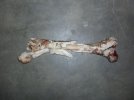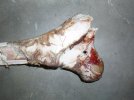Samesaw
Well-Known Member
- Joined
- Aug 15, 2012
- Messages
- 47
View attachment 303682This is an antelope that I shot at the other day. The shot was 800 yards on the button. I am shooting a 338 rum pushing 300 grain Berger EH's. This is the first antelope I have shot at with this setup. I was expecting different results to say the least.
I made the shot and he took off. Initially I thought I missed. After reviewing the video I realized I put a pretty decent hit on him. He ran over the back side of the ridge so I figured he would be toast just out of sight. I walked over to retrieve him and as I crested the ridge he was on, I saw him on the next ridge back, over 1k yards away, with the same 3 does. I got a look at the exit side and there was a good stream of blood all down his Left side to confirm the hit and placement. He went up and over and I figured I would leave him for the night.
The next morning at daylight i was back with a buddy to recover him, as I was sure he would be toast. After a bit of hiking around sure enough there he was, running down a ridge a couple hundred yards away. Into a draw and up and over another ridge. Then up and over another. I could see blood stains all down his entry side which confirmed he was the same one.
I did not get an opportunity for another shot. I continued hiking in the direction he went and hiked and glasses for the next couple hours with no luck finding him. At that point he was alive and appeared to be doing just fine. Neither one of us were able to locate him again.
I have attached a link to a video as well as a screenshot of the impact frame.
From the more experienced guys, whats the consensus here? Too far back? Too high? Bullet did not perform properly? Antelope did not have enough mass to instigate terminal performance? Ex-con goat who was just downright tough as nails?
I must say I was expecting more of a bang flop type of scenario on an antelope with this rifle.
I would like to know where I went wrong.
Well the video shows a hit above his gut into the near back loins area, yet he ran away which should have been impossible with an expanding bullet. I'd say your Calibre is better suited for much larger game within 300 yards, antelope are easily taken with lighter high velocity cartridges like .243 Win 80gr, or .270 Rem 120gr or even a lighter 150gr .30-06.
Looks like your bullet did not expand, otherwise it would have been a bang flop.
In my humble opinion.
Cheers Mate.


